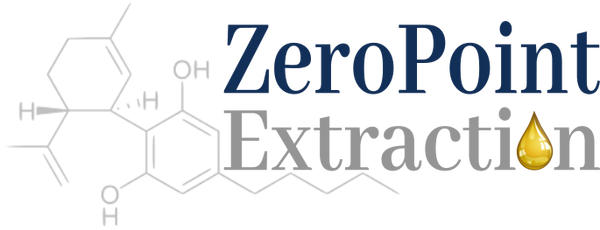Recent posts
-

-
 What Are THCa Diamonds?October 14, 2025
What Are THCa Diamonds?October 14, 2025 -
 Delta 9 Gummies GuideOctober 8, 2025
Delta 9 Gummies GuideOctober 8, 2025 -
 Head High vs Body High: A Guide to Cannabis EffectsOctober 1, 2025
Head High vs Body High: A Guide to Cannabis EffectsOctober 1, 2025 -
 What is THCA Crumble?September 22, 2025
What is THCA Crumble?September 22, 2025 -
 10 Ways to Elevate Self-Care Awareness MonthSeptember 14, 2025
10 Ways to Elevate Self-Care Awareness MonthSeptember 14, 2025

What is THCA?
By Zero Point
Table of Contents
Introduction to THCA
Tetrahydrocannabinolic acid, or THCA, stands as a cornerstone in the complex structure of cannabis chemistry, representing one of the many cannabinoids that contribute to the plant's therapeutic and medicinal potential. Unlike THC, the cannabinoid famous for its psychoactive effects, THCA does not intoxicate users. Instead, it resides in the raw and living cannabis plant as a non-psychoactive precursor to THC, transforming into the well-known psychoactive compound only when exposed to heat or sunlight in a process known as decarboxylation.
The significance of THCA extends beyond its role as a chemical precursor; it embodies the untapped potential of cannabis in its raw form. With the growing interest in cannabis for health and wellness, understanding the properties and benefits of THCA is essential. The compound interacts with the body's endocannabinoid system, a complex network that plays a vital role in regulating a variety of physiological and cognitive processes, including appetite, pain sensation, mood, and memory. This interaction suggests that THCA, like other cannabinoids, may offer a range of therapeutic benefits.
The exploration of THCA is at the forefront of expanding our comprehension of cannabis and its myriad uses. As we delve deeper into the science behind THCA, we uncover the nuanced differences that set it apart from THC and other cannabinoids, highlighting the importance of precise knowledge in leveraging cannabis for medical and therapeutic purposes. This introductory overview sets the stage for a detailed examination of THCA's chemical structure, its benefits and uses, legal status, and its distinct characteristics compared to THC, offering a comprehensive guide to understanding this unique compound.
Scientific Background of Tetrahydrocannabinolic Acid
Tetrahydrocannabinolic acid, is a fascinating compound found in the cannabis plant, primarily in its raw and unprocessed form. Its presence and role within the plant's anatomy, along with the process through which it converts to THC, are central to understanding the therapeutic potential and chemical complexity of cannabis. This section delves into the chemical structure of THCA, its biosynthesis within the cannabis plant, and the decarboxylation process that transforms it into THC.
Chemical Structure of THCA
At the molecular level, THCA is distinguished by its carboxylic acid group, which differentiates it from THC. This structural distinction is crucial, as it is responsible for the non-psychoactive nature. The molecule consists of a 22-carbon framework, including a pentyl (5 carbon) side chain. THCA is one of the primary cannabinoids produced by the trichomes of the cannabis plant, serving as the acidic precursor to THC.
Biosynthesis in the Cannabis Plant
The journey of THCA begins in the trichomes, the resin glands of the cannabis plant, where it is synthesized through a specific biochemical pathway. CBGA (cannabigerolic acid), often referred to as the "mother of all cannabinoids," is the initial cannabinoid formed in the plant. Through the action of the enzyme THCA synthase, CBGA is converted into THCA. This process is influenced by the plant's genetics, environmental conditions, and the developmental stage of the plant, leading to variations in concentration across different strains and growth conditions.
The Decarboxylation Process
Decarboxylation is a chemical reaction that removes a carboxyl group from a molecule, releasing carbon dioxide (CO2). In the context of cannabis, decarboxylation is the process through which THCA is heated, transforming it into psychoactive THC. This reaction can occur naturally over time through aging or more rapidly when cannabis is smoked, vaporized, or cooked. The removal of the carboxylic acid group from THCA not only activates THC's psychoactive effects but also changes the way it interacts with the body's endocannabinoid system, thereby altering its therapeutic potential.
The decarboxylation of THCA to THC is a critical factor in the consumption of cannabis, as it influences the effects experienced by the user. Understanding this process is essential for both consumers and medical practitioners to effectively utilize cannabis for its psychoactive properties or for its potential health benefits in its raw form.
Implications of THCA's Chemical Nature
The chemical structure and properties of THCA have significant implications for its therapeutic use and legal status. As a non-psychoactive compound, it offers potential health benefits without the intoxicating effects associated with THC. Additionally, the process through which it is converted to THC — and the factors influencing this transformation — are of great interest for the cultivation, storage, and consumption of cannabis, affecting everything from product formulation to dosing strategies.
In summary, the scientific background of THCA underscores its importance in the cannabis plant's life cycle and its potential applications. Understanding the chemical nature and the processes that influence its conversion to THC is foundational to advancing our knowledge of cannabis and its uses. This exploration sets the stage for a deeper examination of the benefits and uses of THCA, shedding light on its potential as a therapeutic agent.
Benefits and Uses of THCA
The exploration of the therapeutic potential is a burgeoning field within cannabis research, propelled by its distinct chemical properties and non-psychoactive nature. This section delves into the possible health benefits, its comparison with THC regarding health effects, and the current landscape of research surrounding this compound.
Potential Therapeutic Benefits
While research is still in its early stages, preliminary studies and anecdotal evidence suggest a variety of potential health benefits. Unlike THC, it does not produce psychoactive effects, making it an appealing option for individuals seeking the therapeutic advantages of cannabis without the associated high. Here are some areas where THCA has shown promise:
-
Anti-inflammatory Properties: it has been suggested to possess potent anti-inflammatory capabilities, which could be beneficial in treating conditions like arthritis and lupus. Inflammation is a common underlying factor in many diseases, and managing it can lead to significant improvements in health and well-being.
-
Neuroprotective Effects: There is emerging evidence that it may have neuroprotective properties, making it potentially useful in the treatment of neurodegenerative diseases such as Parkinson's disease and Alzheimer's disease. Its ability to protect neuronal cells from damage could help slow the progression of these conditions.
-
Antiemetic Effects: it may also be effective in reducing nausea and vomiting. This could be particularly beneficial for patients undergoing chemotherapy, who often suffer from these debilitating side effects.
-
Antiproliferative Effects: Preliminary research indicates that it might possess anticancer properties by inhibiting the proliferation of cancer cells. While much more research is needed to fully understand its efficacy in cancer treatment, this represents a promising area of study.
It's important to note that while these potential benefits are encouraging, they are based on preclinical studies and require further investigation through clinical trials to fully understand therapeutic potential and efficacy.
Comparison with THC Regarding Health Effects
THCA and THC share some similarities in their potential health benefits, particularly regarding anti-inflammatory and neuroprotective effects. However, their most significant difference lies in their psychoactivity. THC is well-known for its psychoactive properties, which can be therapeutic for some conditions but undesirable or even detrimental for others. THCA offers an alternative for those looking to avoid the psychoactive effects while still harnessing the therapeutic benefits of cannabis.
Furthermore, the non-psychoactive nature means it can be used in higher doses than THC, potentially leading to more significant therapeutic effects without the risk of psychoactive side effects. This aspect is particularly appealing for medical use, where precise dosing and the absence of intoxication are often crucial.
Current Research and Studies on THCA
The body of research is growing, with studies focusing on its molecular mechanisms, pharmacological properties, and potential therapeutic applications. Most research to date has been preclinical, involving cell cultures and animal models, and there is a pressing need for clinical trials to evaluate efficacy and safety in humans.
One of the challenges in researching THCA is its instability; it readily converts to THC when exposed to heat or UV light, complicating the study of its pure form. Despite these challenges, ongoing research is exploring innovative formulations and extraction methods to stabilize it for medical research and therapeutic use.
Implications for Consumers and the Cannabis Industry
The potential health benefits of THCA have significant implications for consumers, particularly those interested in the medicinal aspects of cannabis. As awareness of its properties grows, demand for THCA-rich products is likely to increase, prompting the cannabis industry to develop new products that preserve the integrity of products.
For consumers, understanding the distinction between THCA and THC is crucial for making informed decisions about cannabis consumption, especially for those seeking the therapeutic benefits of cannabis without the psychoactive effects. As research progresses, we can expect to see a broader range of products and applications, tailored to meet the needs of diverse patient populations.
In summary, THCA holds promise as a therapeutic agent, with potential benefits that distinguish it from its psychoactive counterpart, THC. As the scientific community delves deeper into the properties and applications of its role in cannabis therapy is likely to expand, offering new possibilities for treatment and wellness.
Legal Status of THCA
The legal status is a complex and evolving issue, reflecting the broader legal landscape surrounding cannabis. Unlike THC, which is widely recognized for its psychoactive properties and is strictly regulated in many jurisdictions, THCA occupies a more ambiguous legal position due to its non-psychoactive nature. This section will explore how it is regulated, the variations in its legal status across different regions, and the implications for consumers and the cannabis industry.
Regulation of THCA
In jurisdictions where cannabis is illegal or tightly controlled, the legal status of THCA often mirrors that of THC, primarily due to its potential to convert into THC through decarboxylation. However, in regions with legal medical or recreational cannabis, it may fall under different regulatory frameworks. The distinction between THCA and THC in legal terms largely depends on how laws are written and interpreted regarding cannabis and its derivatives. Some regulations specifically target THC and its psychoactive effects, while others may broadly encompass all cannabinoids.
Variations in Legal Status
The legal status can vary significantly from one country to another and even within different states or provinces within a country. For example, in the United States, federal law does not explicitly distinguish between THCA and THC, categorizing all marijuana-derived compounds as Schedule I substances under the Controlled Substances Act. However, state laws can differ, with some states allowing the use of cannabis and its derivatives, for medical or recreational purposes.
In contrast, some countries in Europe and elsewhere may have more lenient policies regarding non-psychoactive cannabinoids, potentially allowing for the legal use and sale of THCA under certain conditions. The global landscape of cannabis regulation is continually changing, with ongoing debates and reforms affecting the legal status of cannabinoids .
Implications for Consumers and the Industry
The ambiguous legal status of THCA presents both challenges and opportunities for consumers and the cannabis industry. For consumers, navigating the legal complexities of THCA can be daunting, especially in regions with conflicting state and federal laws. It's essential for individuals to stay informed about the legal status of THCA and other cannabinoids in their jurisdiction to avoid legal complications.
For the cannabis industry, the evolving legal landscape offers the potential to innovate and expand the market for THCA products, especially in regions with legal medical or recreational cannabis. However, companies must also navigate the regulatory challenges associated with producing and selling THCA, including compliance with laws regarding cannabis cultivation, processing, and sale.
In summary, the legal status of THCA is a nuanced and dynamic issue, reflecting broader trends in cannabis legalization and regulation. As legal frameworks continue to evolve, the recognition of THCA's unique properties and potential benefits may lead to more nuanced policies that differentiate between non-psychoactive and psychoactive cannabinoids.
THC vs THCA?
The comparison between Tetrahydrocannabinolic Acid (THCA) and Tetrahydrocannabinol (THC) is essential for understanding the multifaceted nature of cannabis and its effects. Despite originating from the same plant, THCA and THC interact differently with the human body, leading to distinct effects and uses. This section highlights the psychoactive properties, medical and recreational uses, and guidance for consumers in choosing between products containing THCA and THC.
Psychoactive Properties
The primary difference between THCA and THC lies in their psychoactive effects. THCA is a non-psychoactive precursor to THC, meaning it does not produce the "high" commonly associated with cannabis use. When cannabis is raw or unheated, THCA is present in high concentrations. It is only through decarboxylation, a process of heating, that THCA is converted into THC, the compound known for its psychoactive effects. This fundamental difference influences how each compound is used for medical and recreational purposes.
Medical Uses
Both THCA and THC have therapeutic potential, but their applications differ due to their psychoactive properties. THCA is gaining attention for its potential anti-inflammatory, neuroprotective, antiemetic, and antiproliferative properties. Because it does not induce psychoactive effects, THCA is an attractive option for patients seeking the medicinal benefits of cannabis without the high, allowing for usage in higher doses without impacting mental clarity.
THC, on the other hand, is utilized for its ability to alleviate pain, stimulate appetite, and reduce nausea, among other benefits. Its psychoactive effects are also therapeutically beneficial for some patients, helping to manage anxiety, depression, and insomnia. However, the psychoactivity of THC limits its suitability for some patients, particularly those sensitive to these effects or those who require treatment without cognitive impairment.
Recreational Uses
In recreational contexts, THC is the compound primarily sought after for its psychoactive effects. Recreational users typically consume cannabis through smoking, vaporizing, or ingesting edibles to experience euphoria, relaxation, and altered sensory perception. THCA, due to its non-psychoactive nature, is less relevant in purely recreational settings but may be valued for its potential to enhance wellness without intoxication.
Consumer Choices
For consumers navigating the world of cannabis products, understanding the distinction between THCA and THC is crucial. Those interested in the therapeutic aspects of cannabis without the psychoactive effects may prefer products high in THCA, such as raw cannabis juices, tinctures, or certain edibles designed to preserve the cannabinoid in its acidic form. Conversely, consumers seeking the psychoactive effects or specific therapeutic benefits associated with THC will opt for products that have undergone decarboxylation.
It's also important for consumers to be aware of the legal status of cannabis products containing THCA and THC in their jurisdiction, as laws vary widely and can affect access and usage. Product labeling and testing are key factors in making informed decisions, as they provide information on cannabinoid content and ensure the safety and efficacy of cannabis products.
In summary, while THCA and THC originate from the same plant, their differences in psychoactivity, medical and recreational uses, and legal status underscore the importance of informed consumer choices in the cannabis market. As research progresses, the understanding and applications of both compounds continue to evolve, offering diverse options for therapeutic and recreational use.
Extraction, Storage, and Consumption of THCA
The extraction, storage, and consumption of THCA are critical processes that preserve the integrity and potency of this non-psychoactive cannabinoid. Understanding these processes is essential for consumers and manufacturers alike to ensure the therapeutic benefits of THCA are maintained from the plant to the end product. This section outlines the methods used to extract THCA from cannabis, best practices for its storage, and popular ways to consume THCA while retaining its unique properties.
Methods of Extracting THCA
Extracting THCA from the cannabis plant involves careful techniques to prevent its conversion into THC. These methods aim to preserve the raw and acidic form of the cannabinoid:
-
Cold Extraction: Techniques such as cold-pressing or using ice water help extract THCA without applying heat, thus preventing decarboxylation. This method is often used to produce THCA-rich concentrates, like bubble hash or rosin, which can be consumed in their raw form or added to products.
-
Solvent-Based Extraction: Using non-polar solvents at low temperatures can also extract THCA without converting it to THC. Solvent-based extractions must be done with care to ensure that all solvent residues are removed from the final product, maintaining its purity and safety.
Storage of THCA
Proper storage is vital to prevent the natural decarboxylation of THCA into THC. To preserve THCA, products should be stored in airtight containers away from direct sunlight and heat, as these factors accelerate the decarboxylation process. Refrigeration or freezing can further prolong the stability of THCA, making it ideal for long-term storage of raw cannabis and THCA-infused products.
Consumption of THCA
Consuming THCA while maintaining its non-psychoactive state involves avoiding heat:
-
Raw Cannabis Juicing: Juicing raw cannabis leaves and buds is a popular method to consume THCA. This technique allows individuals to ingest THCA in its natural form, leveraging its potential health benefits without inducing psychoactive effects.
-
Tinctures: Creating tinctures by soaking raw cannabis in a solvent at low temperatures can extract THCA, which can then be consumed sublingually. This method offers precise dosing and rapid absorption without heat, preserving THCA's properties.
-
Edibles and Cold Foods: Certain edibles avoid heat in their preparation to keep cannabinoids in their raw state. Incorporating raw cannabis into salads or creating THCA-infused cold dishes are examples of how to consume THCA through edibles.
-
THCA Flower: THCA flower refers to raw, unheated cannabis that naturally contains high levels of THCA. Consumers can use THCA flower in various ways that do not involve heating to preserve its non-psychoactive properties. For instance, it can be used to make tinctures or included in raw cannabis edibles. However, it's essential to avoid smoking or vaporizing THCA flower if the goal is to consume THCA specifically, as these methods will convert THCA into THC through decarboxylation.
The careful extraction, storage, and consumption of THCA are essential for harnessing its full therapeutic potential. As interest in non-psychoactive cannabinoids grows, the cannabis industry is likely to continue evolving, offering more innovative and effective ways to utilize THCA for health and wellness.
The Future of THCA in Cannabis Research and Therapy
As the cannabis industry and scientific community continue to evolve, the future of THCA holds promising prospects for research and therapeutic applications. Emerging studies are beginning to shed light on the complex role of THCA in the cannabis plant and its potential benefits for human health. This concluding section explores the emerging trends, potential applications, and challenges that lie ahead in the realm of THCA research and therapy.
Emerging Research on THCA
Research on THCA is expanding, with scientists exploring its pharmacological properties and therapeutic potential in greater depth. As understanding of the endocannabinoid system and cannabinoid pharmacology advances, the specificity of THCA's interactions with various receptors and enzymes is coming into clearer focus. These studies are crucial for identifying potential therapeutic applications and understanding the mechanisms underlying THCA's effects.
Potential Applications and Challenges
The potential for THCA in therapeutic applications is vast, ranging from its use in inflammation and pain management to neuroprotection and anti-cancer therapies. However, realizing this potential requires overcoming challenges such as the stability of THCA, its delivery methods, and the regulatory landscape governing cannabis research and product development.
Evolving Landscape of Cannabis-Based Treatments
The interest in non-psychoactive cannabinoids like THCA is contributing to an evolving landscape of cannabis-based treatments. As regulatory barriers are navigated and public perception shifts, the integration of THCA into clinical practice and consumer products is likely to grow. This will necessitate continued research, innovation in product development, and education to ensure the safe and effective use of THCA.
In conclusion, the future of THCA in cannabis research and therapy is bright, with ongoing studies and a growing interest in non-psychoactive cannabinoids paving the way for new therapeutic applications. As our understanding of THCA deepens, its potential to contribute to health and wellness becomes increasingly apparent, marking an exciting frontier in the exploration of cannabis and its compounds.








